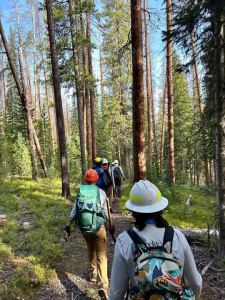Rocky Mountain Conservancy Conservation Corps Brings in Largest Crew to Celebrate 20-Year Anniversary
Twenty years ago, the Rocky Mountain Nature Association (now the Rocky Mountain Cons

Since the first six Corps members were recruited and put to work in the field in 2003, the Rocky Mountain Conservancy’s Conservation Corps program has steadily grown and become an essential partner to RMNP and the U.S. Forest Service lands adjacent to RMNP, preserving natural and cultural resources each summer since 2003. Visitors to these public lands reap the rewards of the corps’ work with improved trails, campgrounds, improved recreational access, improvements to facilities, and protecting critical river corridors along the Colorado and Cache Le Poudre Rivers.
Instead of pausing for cake and champagne on this milestone 20th anniversary, however, the Conservancy’s board of directors and program coordinators are commemorating the anniversary in a more spectacular fashion: by fielding the largest Conservation Corps in history and taking on more trail construction, more historic preservation, planting more native vegetation, and more post-wildfire forest restoration than ever before. This season, 54 individuals—from 28 states–across nine separate crews will work in three different U.S. Forest Service Ranger Districts, and four different departments in Rocky Mountain National Park.
“We’re not necessarily looking for the biggest, strongest individuals or those who already have chainsaw, backpacking or trail building experience. We can and will teach all that,” said Ian Stafford, Director of Stewardship and Policy at the Conservancy. “What we’re really looking to do is bring together a diverse group of young people who have heart, grit, and a passion for our environment. The learning and development really begins when you get young people working and living together and creating something more important than themselves.”
In any given year, the Conservation Corps’ physical accomplishments are impressive. In 2022, for example, Corps members worked at 60 public land sites, improved 309 miles of trail and 15 miles of river corridor, constructed 12 bridges and 463 linear feet of rock wall, restored 24 backcountry campsites lost in the historic wildfires of 2020, provided critical maintenance to a historic visitor center in RMNP, and collected 139 slash piles in preparation for pile burns to reduce wildfire fuels.


Plans for 20233 are even more ambitious and include assisting park staff with more trail improvements (such as more work on the Green Mountain trail system), beginning tent pad rehabs in RMNP’s largest campground, wetland restoration, continuing work to harden and improve the immensely popular Longs Peak Trail, and many more jobs across Northern Colorado. As in previous years, projects are located throughout RMNP—both east and west sides—as well as sites around the Arapaho-Roosevelt National Forest in Larimer, Grand, Gilpin, Jackson, and Boulder counties.
From the corps’ inception, grants and philanthropy have been essential to the success and growth of Rocky Mountain Conservancy’s Conservation Corps programs. The National Park Foundation recently awarded more than $240,000 in grants to the Conservation Corps and its sister program for younger adults, the High School Leadership Corps. The Conservation Corps also receives support as part of the federal AmeriCorps program, and individual donors are key to keeping the corps members in training and supplies.
“Individual donors and foundation funders are vital components of maintaining and growing the size of corps crews. These crews provide the teams the park and forest service simply do not have the capacity to support,” said Estee Rivera Murdock, executive director of Rocky Mountain Conservancy. “We also believe corps graduates who pursue different paths—maybe go on to be teachers or nurses or enter business—will still be influential environmental stewards by passing on corps conservation ethics to their families and communities.”
Through the Conservancy Conservation Corps, young adults from across the country (aged 18-30) participate in an 11-week program that provides professional development, networking opportunities, skills development, immersive outdoor conservation experiences, and career education and exploration in the conservation space. Participants receive full uniforms from the hats on their heads to the boots on their feet, stipends, access to free gear rentals for the entire season, and rustic housing ranging from tents to Forest Service cabins. By providing gear and uniforms, the Conservancy removes a major financial barrier to these team members in getting outdoors and developing their love and knowledge of natural places. From 2003’s inaugural 6-person Conservation Corps, to 2022’s 52-person team, more than 500 young adults from across the United States have come through this program in the last 20 years.
You can support the Conservation Corps and High School Leadership Corps programs by donating to the Rocky Mountain Conservancy’s Conservation Corps Fund.
